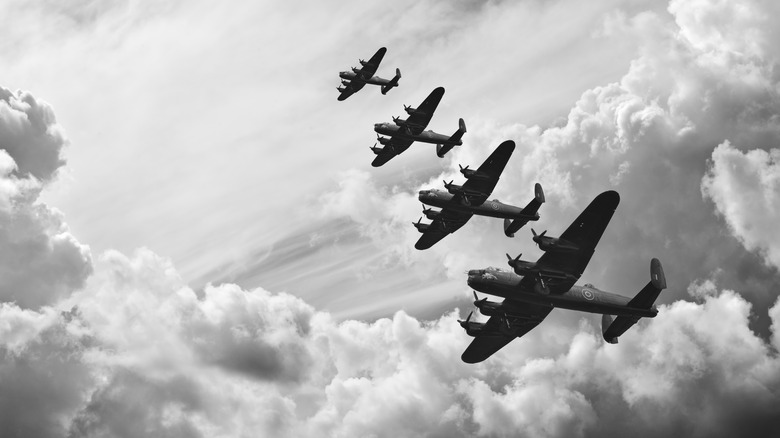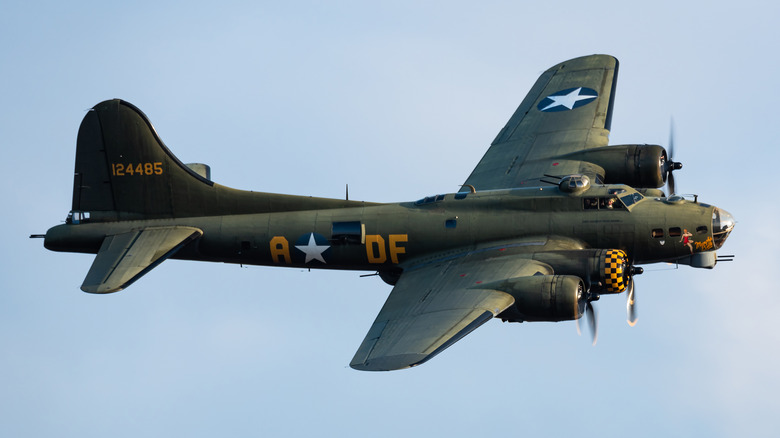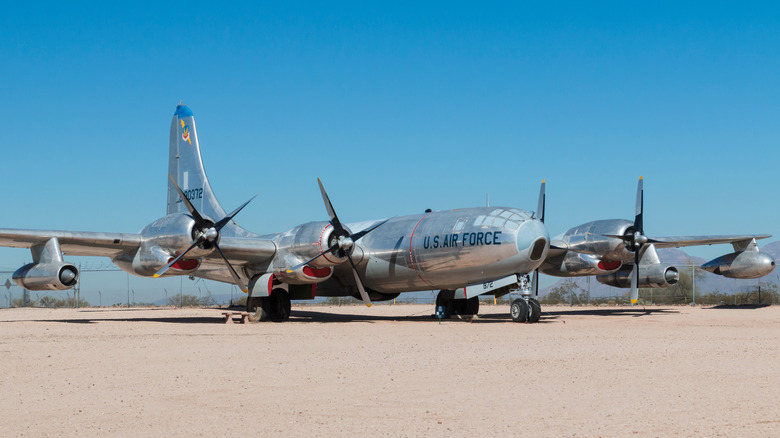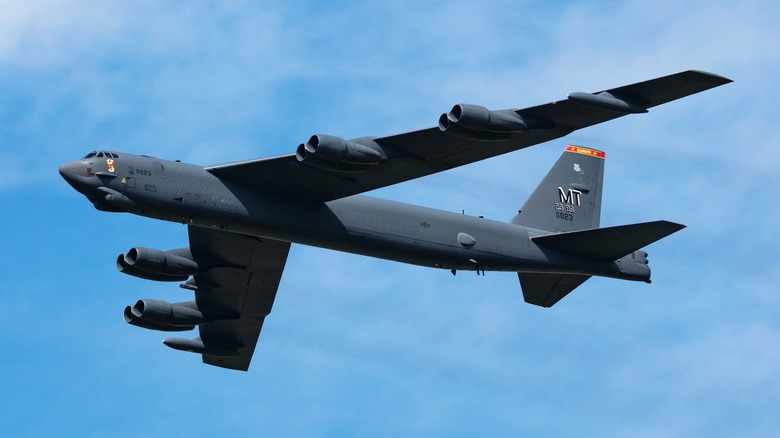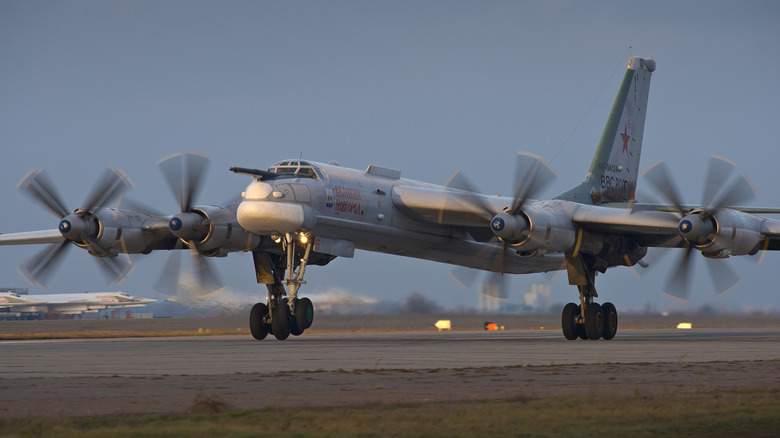We Asked ChatGPT What The Best Bomber Ever Made Is. Here's What It Said
All of SlashGear's content is 100% original and written and edited by real, live humans. We do not use AI chat tools to generate, ideate, or draft our content.
Aerial weapons systems have continued to progress through the ages. From the time of the first airborne dogfights during World War I to the present, national military forces have been innovating tirelessly to maintain a competitive edge in the event of future conflict. The first aircraft to fly in the armed forces were utilized as reconnaissance tools, but the platform quickly evolved into a combat augmentation, and by World War II, heavy aircraft that could drop bombs over enemy positions had taken to the skies en masse alongside sleek fighter planes.
The importance of bombers can't be overstated in the modern context of warfare. Therefore, we fired up a conversation with ChatGPT to get its take on the best bombers that have ever flown. "The answer to this question is subjective and depends on various factors such as the intended use, historical context, technological advancements, and personal preferences," it started.
"However, some of the most iconic and influential bombers in history include the B-17 Flying Fortress, which was used extensively by the Allied forces during World War II; the B-29 Superfortress, which was instrumental in dropping the atomic bombs on Hiroshima and Nagasaki; the B-52 Stratofortress, which is still in service today and is capable of delivering nuclear and conventional weapons; and the Russian Tupolev Tu-95 "Bear," which is the fastest and longest-serving turboprop bomber in history," ChatGPT noted.
B-17 Flying Fortress
The Flying Fortress is the first aircraft highlighted by ChatGPT. This is the earliest bomber on the list, and one of the first American-made bombing aircraft to roll out of a factory. The first was GMB-1, lifting off on its maiden flight in 1918. But less than 20 years later, the B-17 launched for the first time on July 28, 1935; its four engines and menacing collage of mounted machine guns led Richard Smith of the Seattle Times to nickname the plane the Flying Fortress as it left the Boeing hangar to complete its first flight.
B-17s became ubiquitous during the Second World War, and Boeing Plant 2 alone built nearly 7,000 of them (across varying model-specific types). 5,745 additional B-17s were built by other manufacturers to quickly add to the Allied war effort. So important was the Flying Fortress that the U.S. air commander in Europe, General Carl Spaatz, once said: "without the B-17 we may have lost the war."
The most recognizable configuration was the B-17E with a measured wingspan of 103 feet, 9 inches, and a maximum takeoff weight of 48,726 pounds. The aircraft could reach a maximum speed of 318 miles per hour at 25,000 feet and was able to extend its altitude to an operational ceiling of 30,000 feet. It could achieve a typical range of 2,000 miles with a standard 6,000-pound bomb load. This aircraft carried 11 total 50-caliber machine guns and as high of a bomb load as 17,600 pounds.
B-29 Superfortress
Shortly after the first flight of the B-17, Boeing began exploring improvements to bomber capabilities. In 1940, the manufacturer submitted a proposal to develop the B-29, a long-range bomber that was capable of more than double the range of the B-17 and greater armament capacity as well. The B-29, dubbed the "Superfortress," could operate with an effective range of 5,830 miles, and carried a dozen 50-caliber machine guns, a 20mm cannon, and 20,000 pounds of bombing munitions.
B-29s were primarily used in the Pacific Theater, and Boeing alone produced 2,766 B-29s in Kansas and Washington. A few hundred others were built in other plants across the country, and production ceased altogether in 1946. These aircraft were used to devastating effect in bombing Japanese positions across the Pacific, and as many as 1,000 at a time engaged in bombing operations over Tokyo before the "Enola Gay," a B-29 itself, dropped the first atomic bomb over Hiroshima.
This was the heaviest bomber ever produced, and indirectly led to the construction of the Tupolev range of aircraft, also noted on this list by the AI. In 1944, four B-29s made emergency landings in Russian territory and were studied intensely to create heavy bombers for the Soviet Union. The result was a divergent, yet strikingly similar range of Tupolev bombers that have served the Soviet Union and Russia through the years.
B-52 Stratofortress
In briefly discussing each of the noted aircraft, ChatGPT was quick to point out that selecting a bomber that was the best among the pack is a difficult task given the uneven timelines of use, specialized purposes and mission parameters, and more. It noted: "Each of these bombers had unique features and capabilities that made them significant in their time, and choosing the 'best' one ultimately comes down to individual opinions and perspectives."
Even with this in mind, it's hard to argue that the B-52, dubbed the "Stratofortress," is topped by any of these other vessels. The B-52 remains in service to this day and makes use of the most advanced technologies and weapons systems of any of the four aircraft highlighted by the AI system. It's also the most recent to take flight, with its first takeoff occurring on August 5, 1954 (compared to a maiden flight by the Tu-95 in 1952).
The B-52 is heavier than its predecessor (the B-29 had a gross weight of 105,000 pounds and the B-52 weights in at a gross figure of 185,000 pounds) and once again improves on the range, with a flight capacity of more than 10,000 miles in the B-52H configuration. The Stratofortress is expected to remain in service for the U.S. Air Force past 2040 and has proven itself in combat throughout many generations of warfare from Vietnam to Afghanistan. The Air Force notes that B-52s dropped 40% of all coalition munitions during Operation Desert Storm, and the aircraft doubles as a naval surveillance vessel, monitoring as much as 140,000 square miles in just two hours.
Tupolev Tu-95
The Tuoplev Tu-95 is the last bomber noted by ChatGPT. Designated by NATO as "Bear," this is a Russian aerial bomber that departs from the jet engines of modern American bombers and instead retains the turboprop design that propelled earlier models into the sky. The plane is enormous, and utilizes four engines with twin, counterrotating propellers that deliver 15,000 horsepower. Tu-95s can cover a range of roughly 7,150 miles, but include aerial refueling equipment that can extend this functional range if necessary.
Like the B-52, this Tupolev bomber remains an active tool in the arsenal of the Russian Air Force. While it was designed as a nuclear bomber and missile delivery system, the Tu-95 experienced combat for the first time as a conventional munitions bomber in Syria from 2015 to 2017. Most commonly throughout its history, the Tu-95 engaged in aerial flyovers on American naval positions throughout the Cold War. The aircraft is deafeningly loud, and combined with its potent weapons capabilities (six KH-55 or KH-55SM long-range cruise missiles and nearly 25,000 pounds of total missile, torpedo, and bomb armaments) served as an excellent sword-rattling option during this period of tension between the United States and the Soviet Union.
